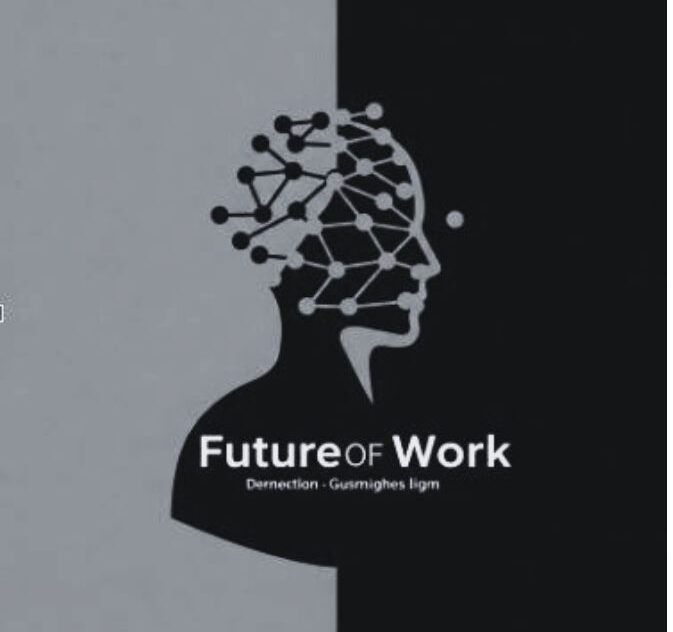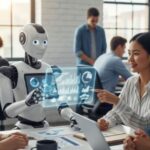Generative AI is here, and it is already changing the way people search, interact and create online content. With new progroms coming on the scene everyday it is hard to imagine the jobs market in a mere few years time. AI is getting better by the day. It is now acting like a tool that can write, code, and generate content with uncanny human-like precision. But while it might seem like a shiny new toy for developers and creative professionals, the rise of generative AI is something that could cause mass disruption to the workforce.
A new report from Brookings Institution, “Generative AI, the American Worker, and the Future of Work,” doesn’t mince words. AI is going to fundamentally reshape the nature of work and it’s not just blue-collar jobs that are at risk. This is a revolution that reaches deep into the heart of white-collar professions.
The question now becomes will we sink or swim?
The AI Tsunami
We’ve seen automation impact manufacturing and routine jobs before, but this time, AI is coming for cognitive work, the kind of knowledge-based, non-routine tasks that have traditionally been the domain of lawyers, engineers, and managers.
According to the Brookings report, a staggering 30% of workers could see at least half of their tasks automated by AI. What’s more, around 85% of workers will experience some degree of disruption, whether it’s a shift in job responsibilities or a complete transformation of their role. Lisa Loud, CEO of Secret Network Foundation, understands the scale of what is facing societies if AI is going to lead to mass unemployment:
“We’re not just talking about automation anymore, we’re talking about a complete reconfiguration of human work. If 30% of workers see half their tasks reshaped by AI, then we have an urgent responsibility to invest in reskilling, and to rethink labor policies. If workers are fired and replaced by AI en-mass with no alternative roles of sustenance offered, then this would surely create mass unemployment – historically a source of tension in any society, and is capable of disrupting any gains from human replacement,” noted Loud.
But here’s the kicker: while AI’s greatest disruption is expected in industries like business, finance, and engineering, sectors once considered “safe” from automation, like law or management, are now on the radar. Think about that next time you’re Googling for legal advice or asking AI to generate your business reports.
4. On AI and economic inequality:
“Yes, it’s a risk—and one we must address head-on. Generative AI can create a winner-takes-most dynamic where a few high-skilled individuals see major gains while mid-skilled knowledge workers face erosion in job security and bargaining power. To counter this, we need deliberate strategies: inclusive access to AI tools so small businesses and individuals can compete; education systems that teach children how to use AI from a young age, state-funded workshops for people who are not well-versed in AI, etc.”
5. On generative AI in robotics and its broader impact:
“The convergence of generative AI with robotics could transform nearly every industry that relies on physical labor and mechanical tasks. Manufacturing, logistics, construction, agriculture, all of these stand to be significantly impacted. We’re already seeing early signs: warehouse robots that can adapt in real time, generative design tools that feed directly into automated production, etc.”
And it’s not just about machines doing the grunt work. AI is rewriting the script on what it means to “work.” From coding to content creation, these advanced systems can complete tasks once thought to require a human touch. When AI can produce polished reports or write blog posts at the speed of light, it’s clear that our relationship with work is going to change dramatically.
The Gender Gap: Women at Risk
If you thought automation only threatened blue-collar workers, think again. The Brookings report highlights a concerning truth: women are more exposed to generative AI than men. Around 36% of female workers are in roles where generative AI could save 50% of their task time, compared to just 25% of men. The reason? Women are more likely to work in white-collar, administrative, and support roles, fields where AI is already making an impact.
This reality challenges the old stereotype that automation only affects factory workers or truck drivers. Women’s overrepresentation in administrative and support roles puts them on the frontline of job displacement, making it crucial to rethink how we approach AI’s role in the workplace. Loud makes a very interesting point of consideration when it comes to replacing women with AI and that is the role of empathy in jobs that require compassion.
“I don’t think women face higher AI exposure and automation risk. In fact, it’s the opposite. For example, woman are very overrepresented in teaching, maternity, and day care roles. Ask Chat-GPT to take care of your child – it can’t. Any job that requires basic human compassion and empathy cannot be replaced by AI. As for white-collar and admin roles, if they purely consist of non-labor, mechanical tasks, then they would be replaced by AI regardless if it was a man, women, or any other gender operating them. Meanwhile, white-collar, leadership professionals who take the time to foster a culture of innovation, listen to their staffs’ human needs, understands and directs their clients’ requests. their work tasks cannot be replaced by AI at all,” says Loud.
The Future of AI: Fast, Autonomous, and Everywhere
Generative AI is unlike anything we’ve seen before. The tools emerging from labs today are faster, more autonomous, and easier to deploy. Unlike past shifts in how we engage with technology, like the rise of the personal computer or smartphones that took years to pervade the workforce, AI is diffusing rapidly. It’s already embedded in apps and browsers that millions use daily, making the barrier to entry almost non-existent.
Another interesting point of consideration is that these systems are being designed to take on sophisticated tasks with little-to-no supervision. Whether it’s coding software, generating research papers, or analyzing complex data, the autonomy of AI means that entire industries could be transformed.
Employers leading with Ethical Considerations
Businesses deploying AI must step up and lead with responsibility. This means assessing both the risks and opportunities AI brings and considering workers’ well-being in every decision. Companies like Microsoft have already started collaborating with worker-led organizations like AFL-CIO, showing that AI doesn’t have to be an adversary. Workers should be engaged in the design and implementation of AI systems, ensuring that productivity gains are shared fairly.
“Yes, it’s a risk—and one we must address head-on. Generative AI can create a winner-takes-most dynamic where a few high-skilled individuals see major gains while mid-skilled knowledge workers face erosion in job security and bargaining power. To counter this, we need deliberate strategies: inclusive access to AI tools so small businesses and individuals can compete; education systems that teach children how to use AI from a young age, state-funded workshops for people who are not well-versed in AI, etc,” says Loud.
In industries where unions are weak, the power dynamics can leave workers vulnerable to rapid technological changes. Worker engagement is critical. As AI becomes more ingrained in the workplace, it’s essential that workers have a say in how these technologies are deployed. Think of the Hollywood writers’ strike. It doesn’t need to be a threat but rather an approach.
Not a ‘Wait-and-See’ Approach
Policymakers need to act fast and smarter. The gap between public concerns about AI and the lack of relevant legislation is widening. Governments can’t afford to be passive bystanders. Instead, they need to develop public policy that addresses AI’s potential harms, such as job displacement, bias, and surveillance. The public sector can set a strong example by becoming a model employer of AI technology, ensuring that worker protections are in place as they adopt AI solutions.
Generative AI has the potential to create faster processes, enhanced productivity, and give us back some well deserved creative time. But as the Brookings report makes clear, these benefits come with risks that must not be ignored. The future of work is something we can actively shape. Everyone working in the AI sphere needs to be conscious of their role in the job replacement or augmentation.
The reality is that AI could dramatically reshape the jobs market, creating new job opportunities while also displacing workers who aren’t prepared for this transformation. To avoid exacerbating inequality and job insecurity, we need to put worker protections at the center of the conversation.
AI is not coming for our jobs, It’s already here, and the future of work will depend on how we manage the change. Will we let it disrupt us, or will we seize the opportunity to make sure that technology benefits everyone?






